Comparison of FPGA and Microcontroller Implementations of an Innovative Method for Error Magnitude Evaluation in Reed–Solomon Codes
Abstract
:1. Introduction
2. Error Magnitude Evaluation in Reed–Solomon Codes
2.1. Forney Method
2.2. Lu Method
3. Hardware Configuration
4. Results and Discussion
5. Conclusions
Author Contributions
Funding
Conflicts of Interest
References
- Wang, J.; Yang, J.Y.; Fazal, I.M.; Ahmed, N.; Yan, Y.; Huang, H.; Ren, Y.; Yue, Y.; Dolinar, S.; Tur, M.; et al. Terabit free-space data transmission employing orbital angular momentum multiplexing. Nat. Photonics 2012, 6, 488–496. [Google Scholar] [CrossRef]
- Saltzberg, B.R. Performance of an Efficient Parallel Data Transmission System. IEEE Trans. Commun. Technol. 1967, 15, 805–811. [Google Scholar] [CrossRef]
- Peterson, W.W.; Brown, D.T. Cyclic Codes for Error Detection. Proc. IRE 1961, 49, 228–235. [Google Scholar] [CrossRef]
- Zhang, Z. Linear network error correction codes in packet networks. IEEE Trans. Inf. Theory 2008, 54, 209–218. [Google Scholar] [CrossRef]
- McAuley, A.J. Reliable Broadband Communication Using a Burst Erasure Correcting Code. In Proceedings of the ACM Symposium on Communications Architectures and Protocols, SIGCOMM, Philadelphia, PA, USA, 26–28 September 1990; Association for Computing Machinery Inc.: New York, NY, USA, 1990; pp. 297–306. [Google Scholar]
- Sudan, M. Decoding of Reed Solomon Codes beyond the Error-Correction Bound. J. Complexity 1997, 13, 180–193. [Google Scholar] [CrossRef] [Green Version]
- Sathananathan, K.; Tellambura, C. Forward Error Correction Codes to Reduce Intercarrier Interference in OFDM. In Proceedings of the ISCAS 2001–2001 IEEE International Symposium on Circuits and Systems, Sydney, Australia, 6–9 May 2001; IEEE: Piscataway, NJ, USA, 2002; Volume 4, pp. 566–569. [Google Scholar]
- Hamming, R.W. Error Detecting and Error Correcting Codes. Bell Syst. Tech. J. 1950, 29, 147–160. [Google Scholar] [CrossRef]
- Bose, R.C.; Ray-Chaudhuri, D.K. On a class of error correcting binary group codes. Infect. Control 1960, 3, 68–79. [Google Scholar] [CrossRef] [Green Version]
- Hocquenghem, A. Codes correcteurs d’erreurs. Chiffres 1959, 2, 147–156. [Google Scholar]
- Poolakkaparambil, M.; Mathew, J.; Jabir, A. Multiple Bit Error Tolerant Galois Field Architectures Over GF(2m). Electronics 2012, 1, 3–22. [Google Scholar] [CrossRef] [Green Version]
- Carlitz, L. The Arithmetic of Polynomials in a Galois Field. Am. J. Math. 1932, 54, 39. [Google Scholar] [CrossRef] [Green Version]
- Reed, I.S.; Solomon, G. Polynomial Codes Over Certain Finite Fields. J. Soc. Ind. Appl. Math. 1960, 8, 300–304. [Google Scholar] [CrossRef]
- Kieseberg, P.; Leithner, M.; Mulazzani, M.; Munroe, L.; Schrittwieser, S.; Sinha, M.; Weippl, E. QR Code Security. In Proceedings of the MoMM 2010—8th International Conference on Advances in Mobile Computing and Multimedia, Paris, France, 8–10 November 2010; pp. 430–435. [Google Scholar]
- Sun, X.; Skillman, D.R.; Hoffman, E.D.; Mao, D.; McGarry, J.F.; McIntire, L.; Zellar, R.S.; Davidson, F.M.; Fong, W.H.; Krainak, M.A.; et al. Free space laser communication experiments from Earth to the Lunar Reconnaissance Orbiter in lunar orbit. Opt. Express 2013, 21, 1865. [Google Scholar] [CrossRef] [PubMed]
- Tan, G.; Herfet, T. Application Layer Hybrid Error Correction with Reed-Solomon Code for DVB Services Over Wireless LANs. In Proceedings of the 2007 International Conference on Wireless Communications, Networking and Mobile Computing, WiCOM 2007, Shanghai, China, 21–25 September 2007; pp. 2952–2955. [Google Scholar]
- Bocharova, I.; Kudryashov, B.; Lyamin, N.; Frick, E.; Rabi, M.; Vinel, A. Low Delay Inter-Packet Coding in Vehicular Networks. Future Internet 2019, 11, 212. [Google Scholar] [CrossRef] [Green Version]
- Shao, H.; Truong, T.; Deutsch, L.; Yuen, J.; Reed, I. A VLSI Design of a Pipeline Reed-Solomon Decoder. IEEE Trans. Comput. 1985, 34, 393–403. [Google Scholar] [CrossRef]
- Moon, H.L.; Seung, B.C.; Jin, S.C. A High Speed Reed-Solomon Decoder. In Proceedings of the IEEE Workshop on VLSI Signal Processing, Sakai, Japan, 16–18 September 1995; IEEE: Piscataway, NJ, USA, 1995; pp. 362–367. [Google Scholar]
- Torres, V.; Valls, J.; Canet, M.J.; García-Herrero, F. Soft-decision low-complexity chase decoders for the RS (255,239) code. Electronics 2019, 8, 10. [Google Scholar] [CrossRef] [Green Version]
- Lee, H. An Area-Efficient Euclidean Algorithm Block for Reed-Solomon Decoder. In Proceedings of the IEEE Computer Society Annual Symposium on VLSI, Tampa, FL, USA, 20–21 February 2003; IEEE: Piscataway, NJ, USA, 2003. [Google Scholar]
- Sarwate, D.V.; Shanbhag, N.R. High-speed architectures for Reed-Solomon decoders. IEEE Trans. Very Large Scale Integr. Syst. 2001, 9, 641–655. [Google Scholar] [CrossRef]
- Forney, G.D. On Decoding BCH Codes. IEEE Trans. Inf. Theory 1965, 11, 549–557. [Google Scholar] [CrossRef]
- Komo, J.J.; Joiner, L.L. Fast Error Magnitude Evaluations for Reed-Solomon Codes. In Proceedings of the IEEE International Symposium on Information Theory, Whistler, BC, Canada, 17–22 September 1995; IEEE: Piscataway, NJ, USA, 1995. [Google Scholar]
- Lu, E.H.; Chen, T.C.; Lu, P.Y. A new method for evaluating error magnitudes of Reed-Solomon codes. IEEE Commun. Lett. 2014, 18, 340–343. [Google Scholar] [CrossRef]
- Mhaske, S.D.; Ghodeswar, U.; Sarate, G.G. Design of Area Efficient Reed Solomon Decoder. In Proceedings of the 2014 2nd International Conference on Devices, Circuits and Systems (ICDCS), Combiatore, India, 6–8 March 2014; IEEE: Piscataway, NJ, USA, 2014. [Google Scholar] [CrossRef]
- Li, X.; Zhang, W.; Liu, Y. Efficient architecture for algebraic soft-decision decoding of Reed-Solomon codes. IET Commun. 2015, 9, 10–16. [Google Scholar] [CrossRef]
- Lee, H. A High-Speed Low-Complexity Reed—Solomon Decoder for Optical Communications. IEEE Trans. Circuits Syst. II Express Briefs 2005, 52, 461–465. [Google Scholar] [CrossRef]
- Clark, G.C.; Cain, J.B. Error-Correction Coding for Digital Communications; Springer: New York, NY, USA, 1981. [Google Scholar]
- Blahut, R.E. Theory and Practice of Error Control Codes; Addison-Wesley Pub. Co.: Boston, MA, USA, 1983; ISBN 9780201101027. [Google Scholar]
- Lin, S.; Costello, D.J. Error Control Coding: Fundamentals and Applications (Prentice-Hall Computer Applications in Electrical Engineerin); Prentice Hall: Upper Saddle River, NJ, USA, 1983; ISBN 013283796X. [Google Scholar]
- Rabaey, J.M.; Potkonjak, M.; Wakabayashi, K. Efficient Throughput Optimization of Feedback Linear Computations Using Generalized Horner’s Scheme. In Proceedings of the 1995 International Conference on Acoustics, Speech, and Signal Processing, Detroit, MI, USA, 9–12 May 1995; IEEE: Piscataway, NJ, USA, 2002. [Google Scholar] [CrossRef]
- Sugiyama, Y.; Kasahara, M.; Hirasawa, S.; Namekawa, T. A method for solving key equation for decoding goppa codes. Infect. Control 1975, 27, 87–99. [Google Scholar] [CrossRef] [Green Version]
- Berlekamp, E.R. Algebraic Coding Theory; McGraw-Hill: New York, NY, USA, 1968. [Google Scholar]
- Chien, R.T.; Watson, T.J. Cyclic Decoding Procedures for Bose-Chaudhuri-Hocquenghem Codes. IEEE Trans. Inf. Theory 1964, 10, 357–363. [Google Scholar] [CrossRef]
- Hu, Q.; Wang, Z.; Zhang, J.; Xiao, J. Low Complexity Parallel Chien Search Architecture for RS Decoder. In Proceedings of the 2005 IEEE International Symposium on Circuits and Systems, Kobe, Japan, 23–26 May 2005; IEEE: Piscataway, NJ, USA, 2005. [Google Scholar] [CrossRef]
- Lin, Y.; Yang, C.; Hsu, C.; Chang, H.; Lee, C. A MPCN-Based Parallel Architecture in BCH Decoders for NAND Flash Memory Devices. IEEE Trans. Circuits Syst. II Express Briefs 2011, 58, 682–686. [Google Scholar] [CrossRef] [Green Version]
- Nergui, M.; Sripati Acharya, U.; Rajendra Acharya, U.; Yu, W.; Dua, S. Reliable Transmission of Retinal Fundus Image with Patient Information using Encryption, Watermarking, and Error Control Codes. In Computational Analysisi of the Human Eye with Applications; World Scientific Publishing: Singapore, 2011; pp. 319–348. [Google Scholar]
- Ejaz, M.Z.; Khurshid, K.; Abbas, Z.; Aizaz, M.A.; Nawaz, A. A Novel Image Encoding and Communication Technique of B/W Images for IOT, Robotics and Drones Using (15,11) Reed Solomon Scheme. In Proceedings of the 2018 Advances in Science and Engineering Technology International Conferences (ASET), Abu Dhabi, UAE, 6 February–5 April 2018; IEEE: Piscataway, NJ, USA, 2018. [Google Scholar]
- European Telecommunications Standards Institute. Digital Video Broadcasting (DVB); Framing Structure, Channel Coding and Modulation for Digital Terrestrial Television; ETSI-EN-300-744; European Telecommunications Standards Institute: Sophia Antipolis, France, June 2009. [Google Scholar]
- CCSDS. TM Synchronization and Channel Coding—Summary of Concept and Rationale; CCSDS: Washington, DC, USA, November 2012. [Google Scholar]
- Bassoli, M.; Bianchi, V.; De Munari, I. A plug and play IoT Wi-Fi smart home system for human monitoring. Electronics 2018, 7, 200. [Google Scholar] [CrossRef] [Green Version]
- Zantalis, F.; Koulouras, G.; Karabetsos, S.; Kandris, D. A Review of Machine Learning and IoT in Smart Transportation. Future Internet 2019, 11, 94. [Google Scholar] [CrossRef] [Green Version]
- Tang, X.; Wang, X.; Cattley, R.; Gu, F.; Ball, A.D. Energy Harvesting Technologies for Achieving Self-Powered Wireless Sensor Networks in Machine Condition Monitoring: A Review. Sensors 2018, 18, 4113. [Google Scholar] [CrossRef] [Green Version]
- Bianchi, V.; Bassoli, M.; Lombardo, G.; Fornacciari, P.; Mordonini, M.; De Munari, I. IoT Wearable Sensor and Deep Learning: An Integrated Approach for Personalized Human Activity Recognition in a Smart Home Environment. IEEE Internet Things J. 2019, 6, 8553–8562. [Google Scholar] [CrossRef]
- Giannetto, M.; Bianchi, V.; Gentili, S.; Fortunati, S.; De Munari, I.; Careri, M. An integrated IoT-Wi-Fi board for remote data acquisition and sharing from innovative immunosensors. Case of study: Diagnosis of celiac disease. Sens. Actuators B Chem. 2018, 273, 1395–1403. [Google Scholar] [CrossRef]
- Bianchi, V.; Boni, A.; Fortunati, S.; Giannetto, M.; Careri, M.; De Munari, I. A Wi-Fi cloud-based portable potentiostat for electrochemical biosensors. IEEE Trans. Instrum. Meas. 2019. [Google Scholar] [CrossRef]
- Brokalakis, A.; Chondroulis, I.; Papaefstathiou, I. Extending the Forward Error Correction Paradigm for Multi-Hop Wireless Sensor Networks. In Proceedings of the 2018 9th IFIP International Conference on New Technologies, Mobility and Security, NTMS 2018, Paris, France, 26–28 February 2018; IEEE: Piscataway, NJ, USA, 2018; Volume 2018, pp. 1–5. [Google Scholar]
- Bettayeb, M.; Ghunaim, S.; Mohamed, N.; Nasir, Q. Error Correction Codes in Wireless Sensor Networks: A Systematic Literature Review. In Proceedings of the 2019 3rd International Conference on Communications, Signal Processing, and their Applications, ICCSPA 2019, Sharjah, UAE, 19–21 March 2019; IEEE: Piscataway, NJ, USA, 2019. [Google Scholar]
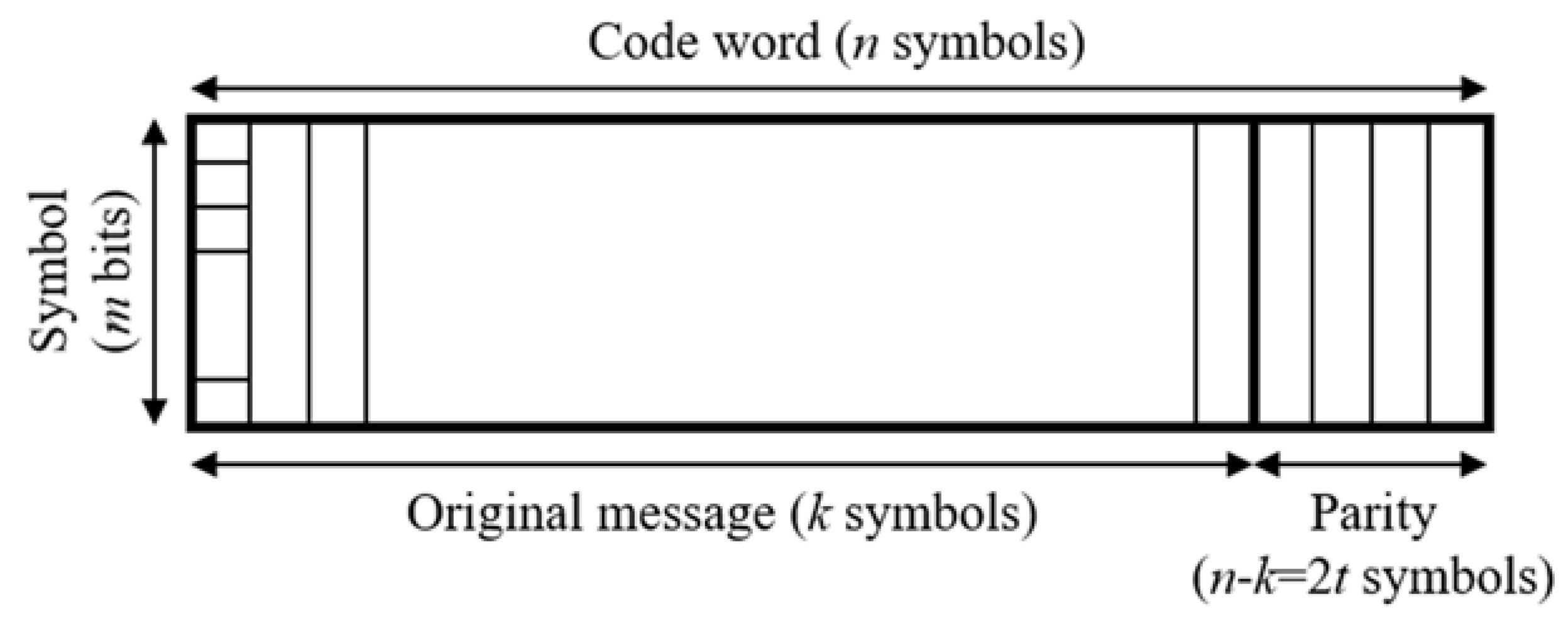

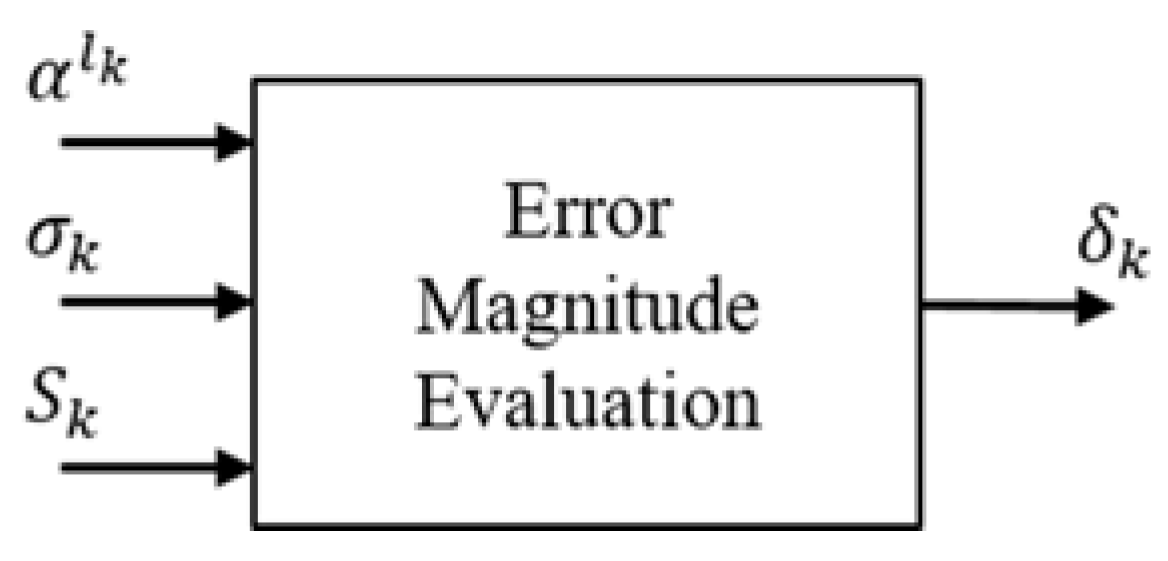
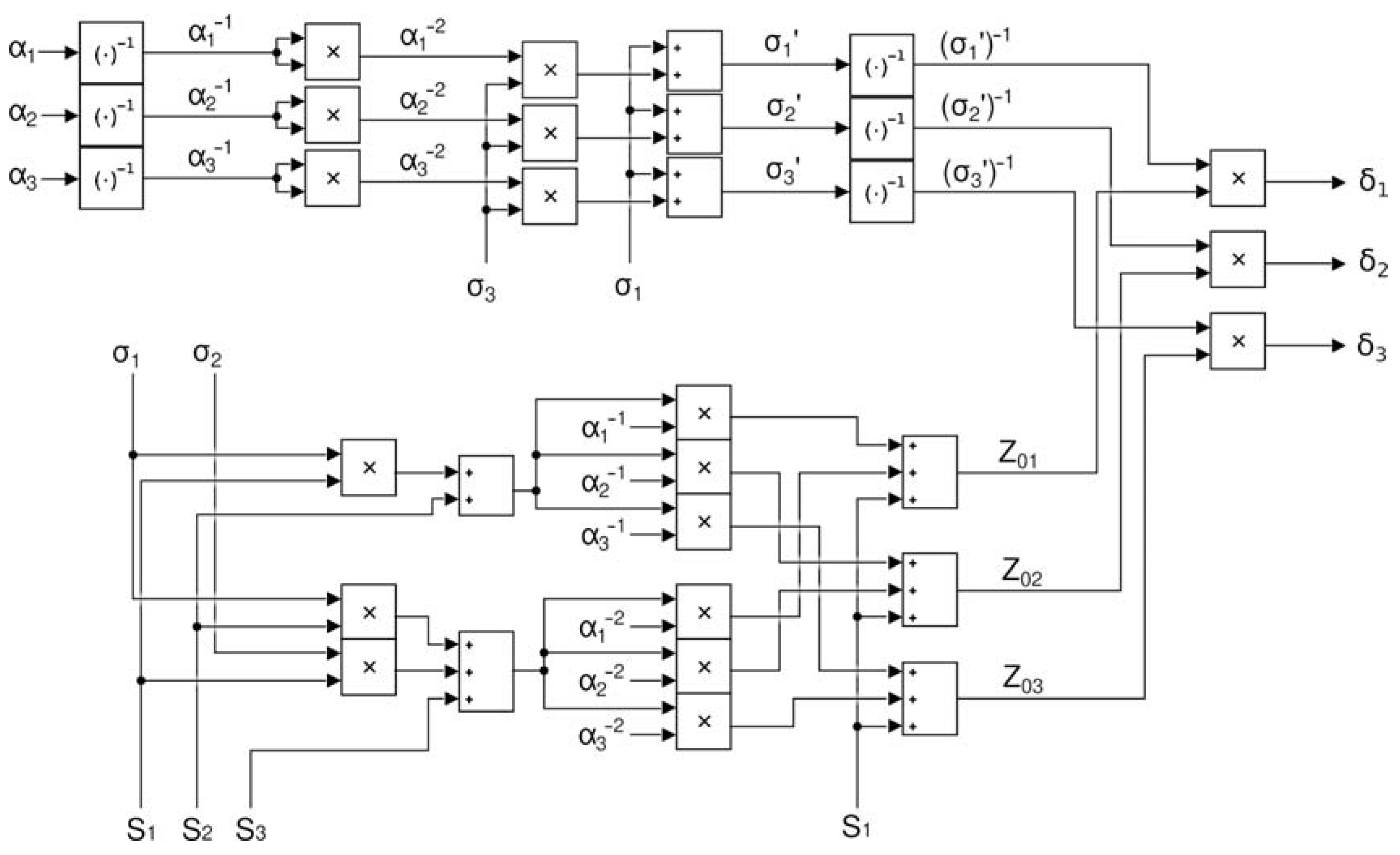
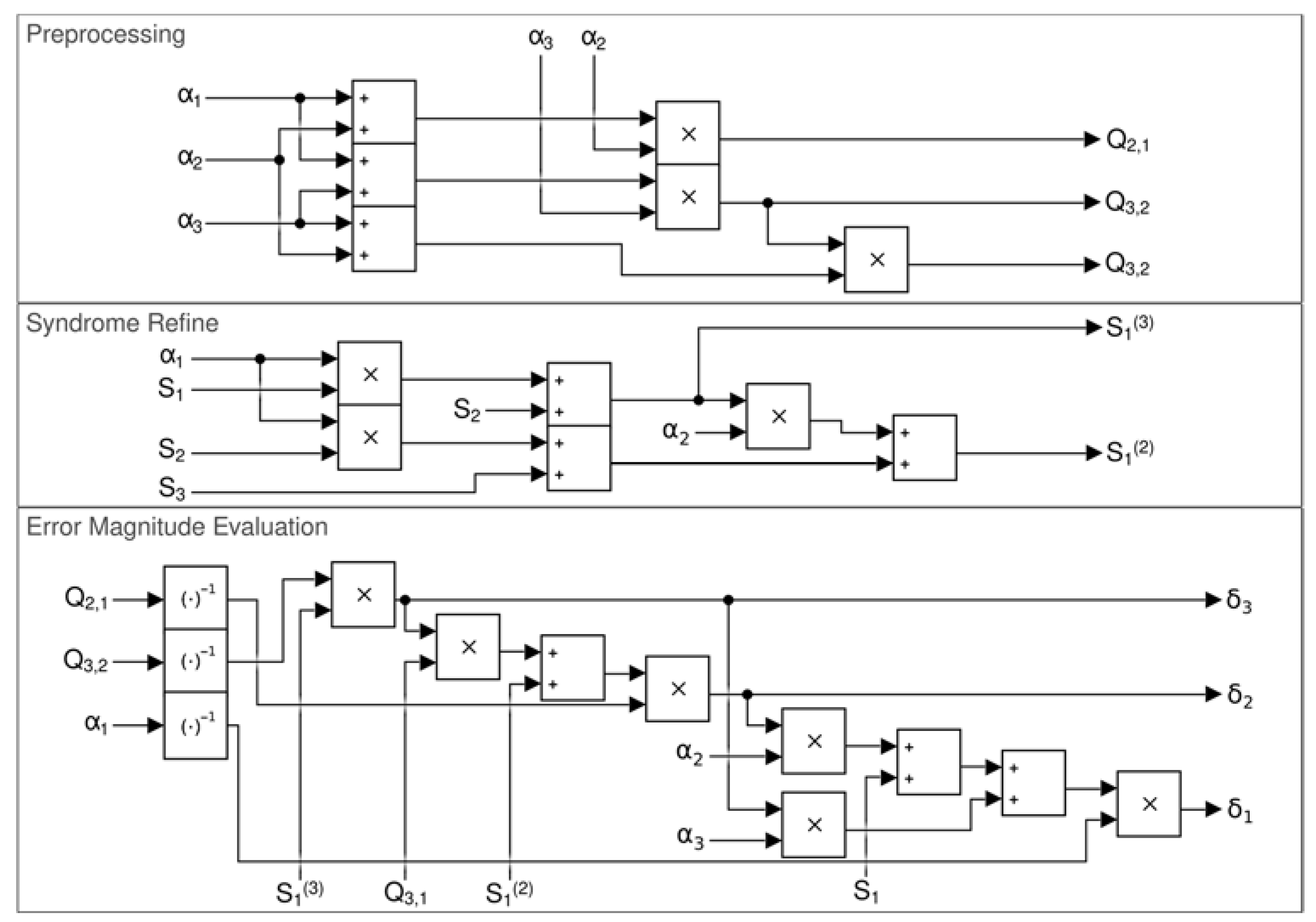


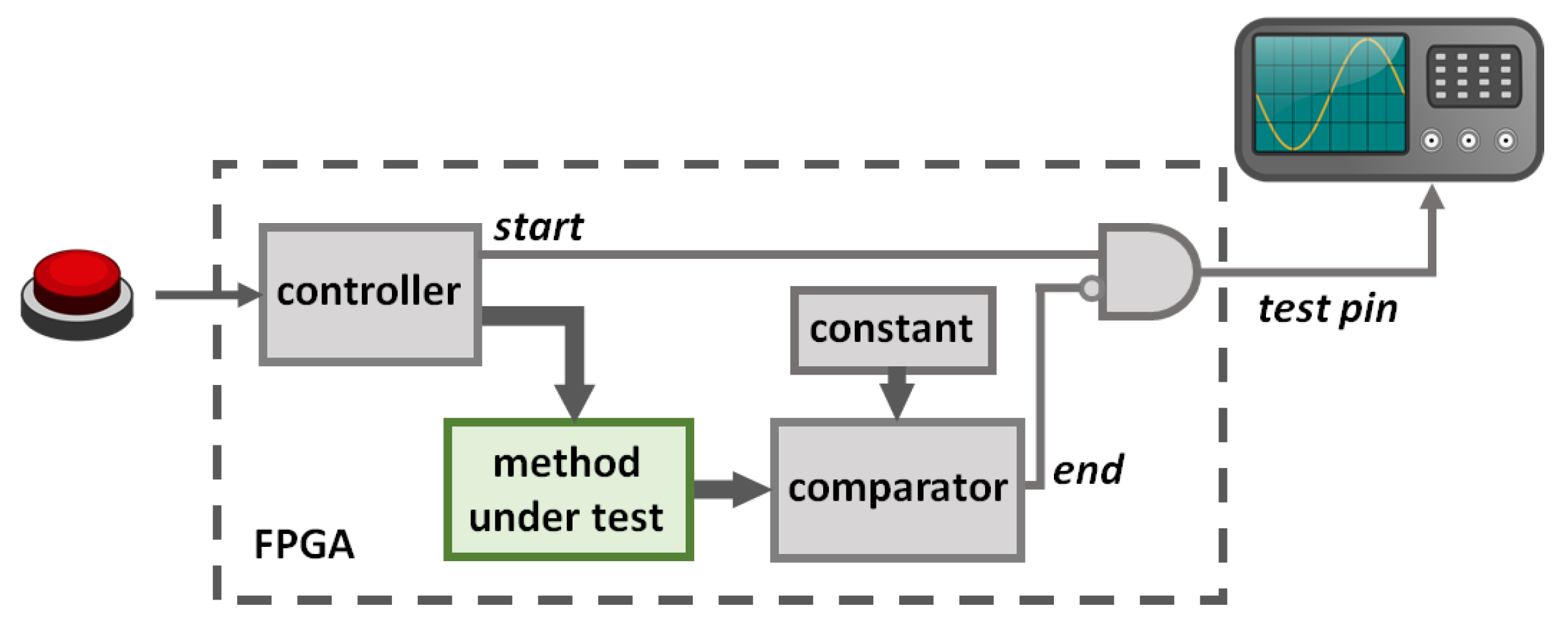
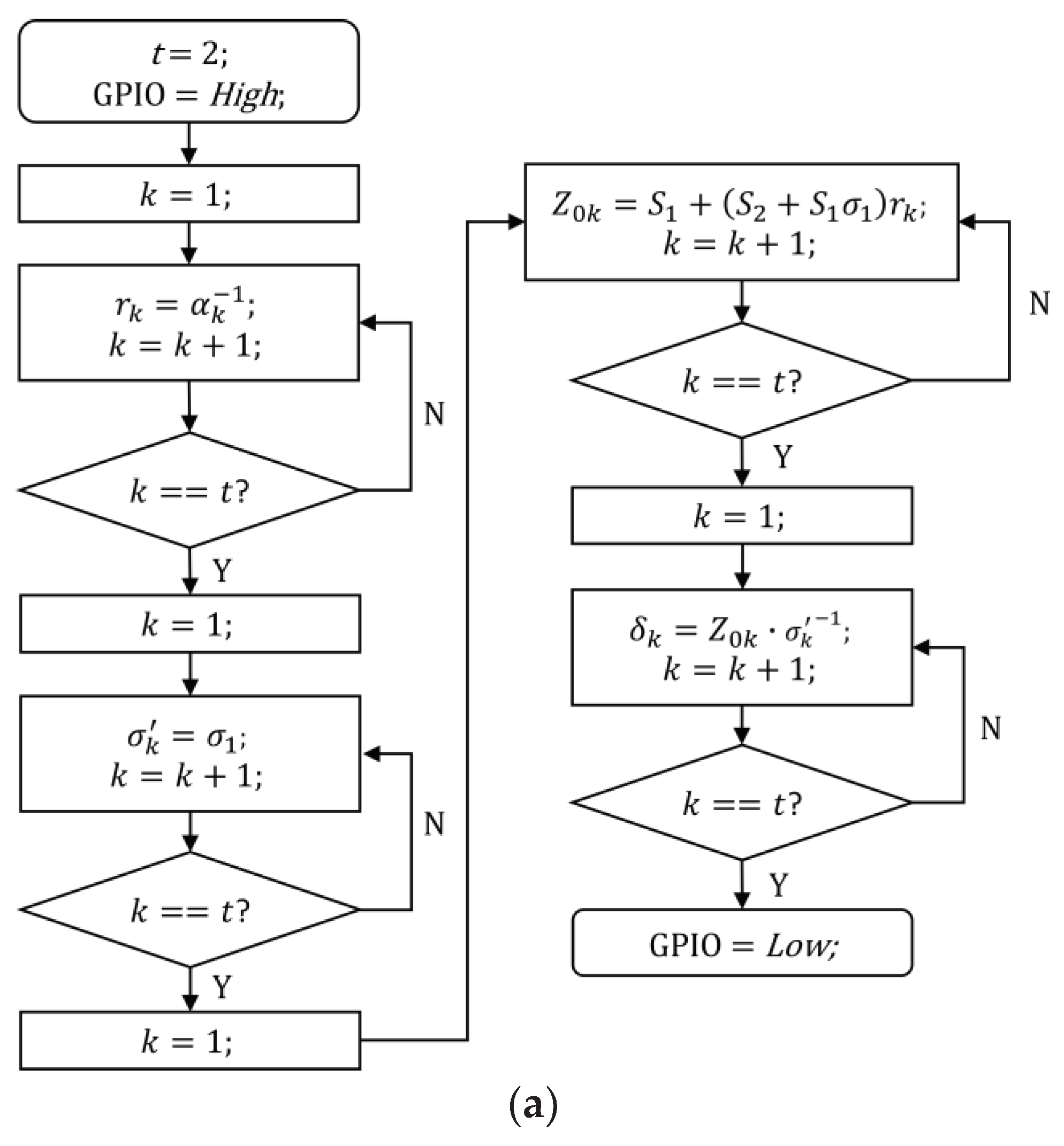
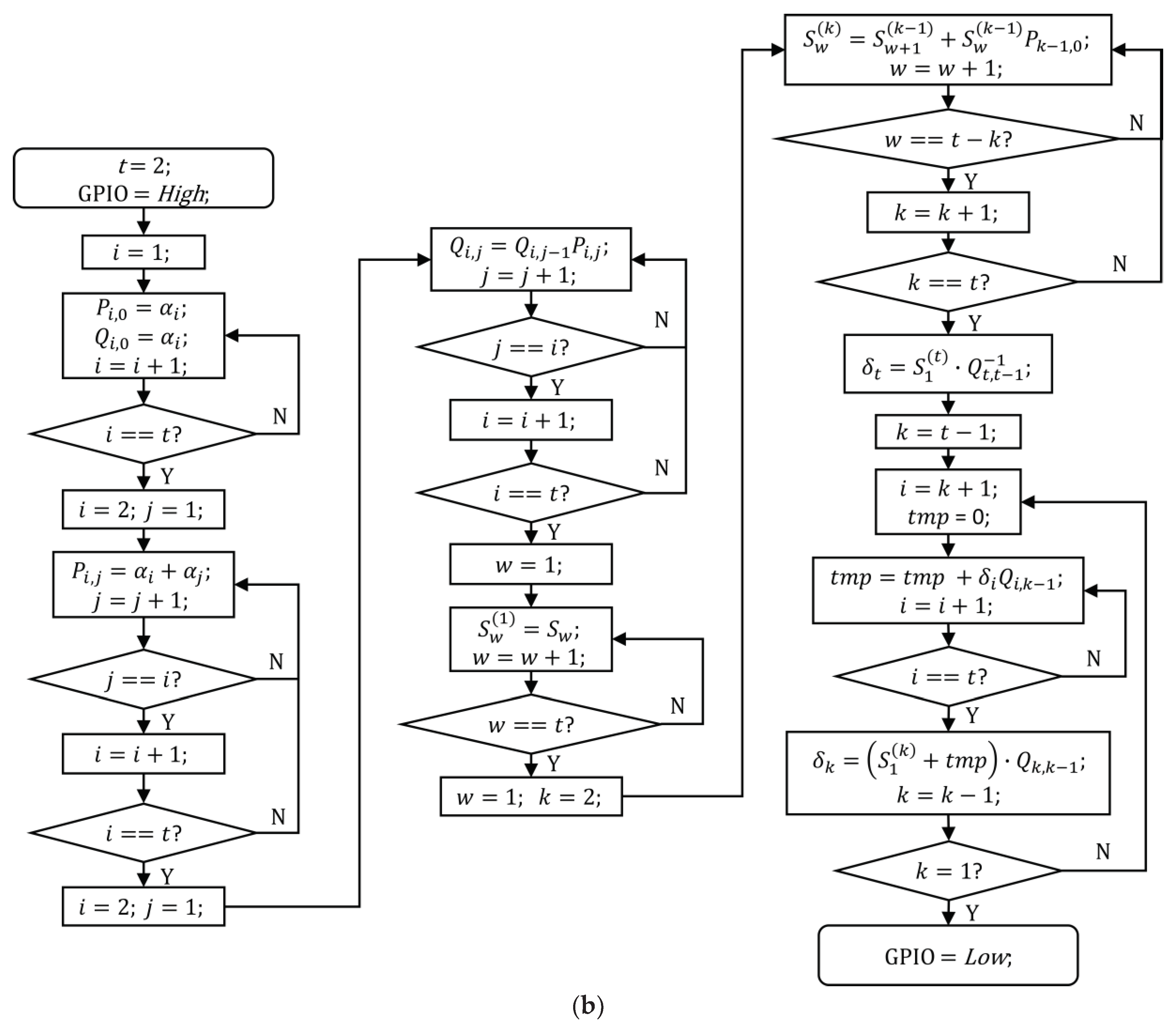
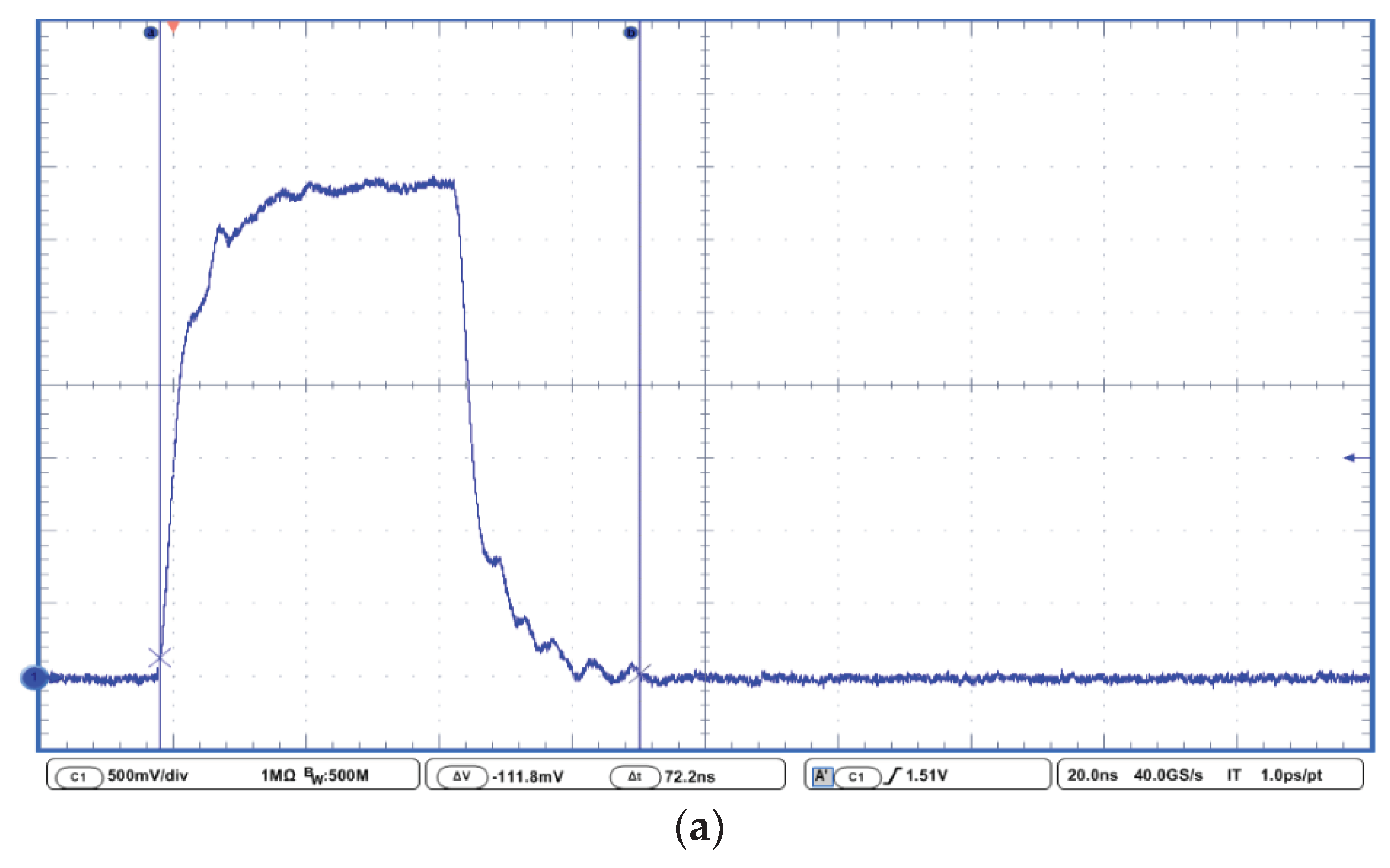
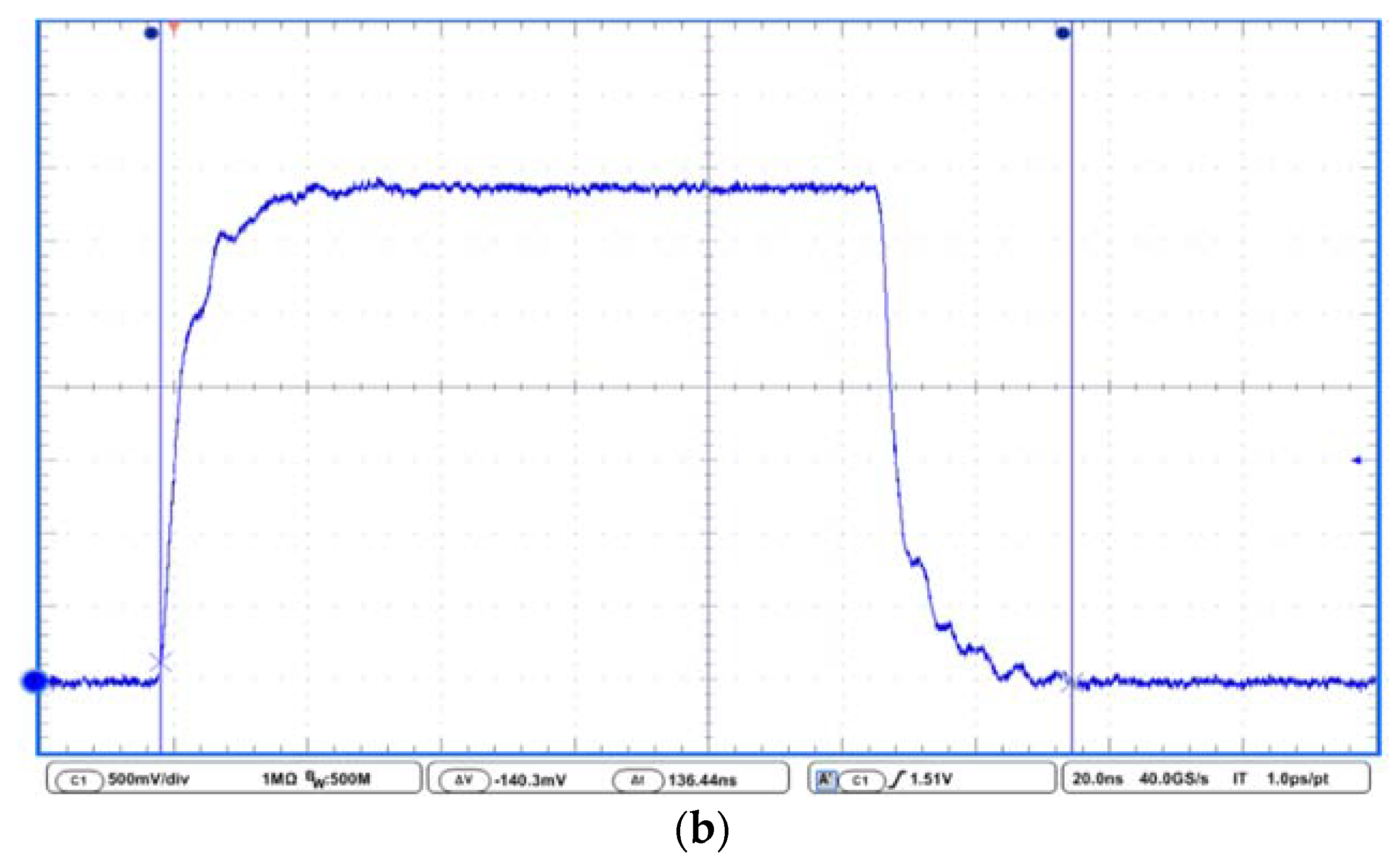
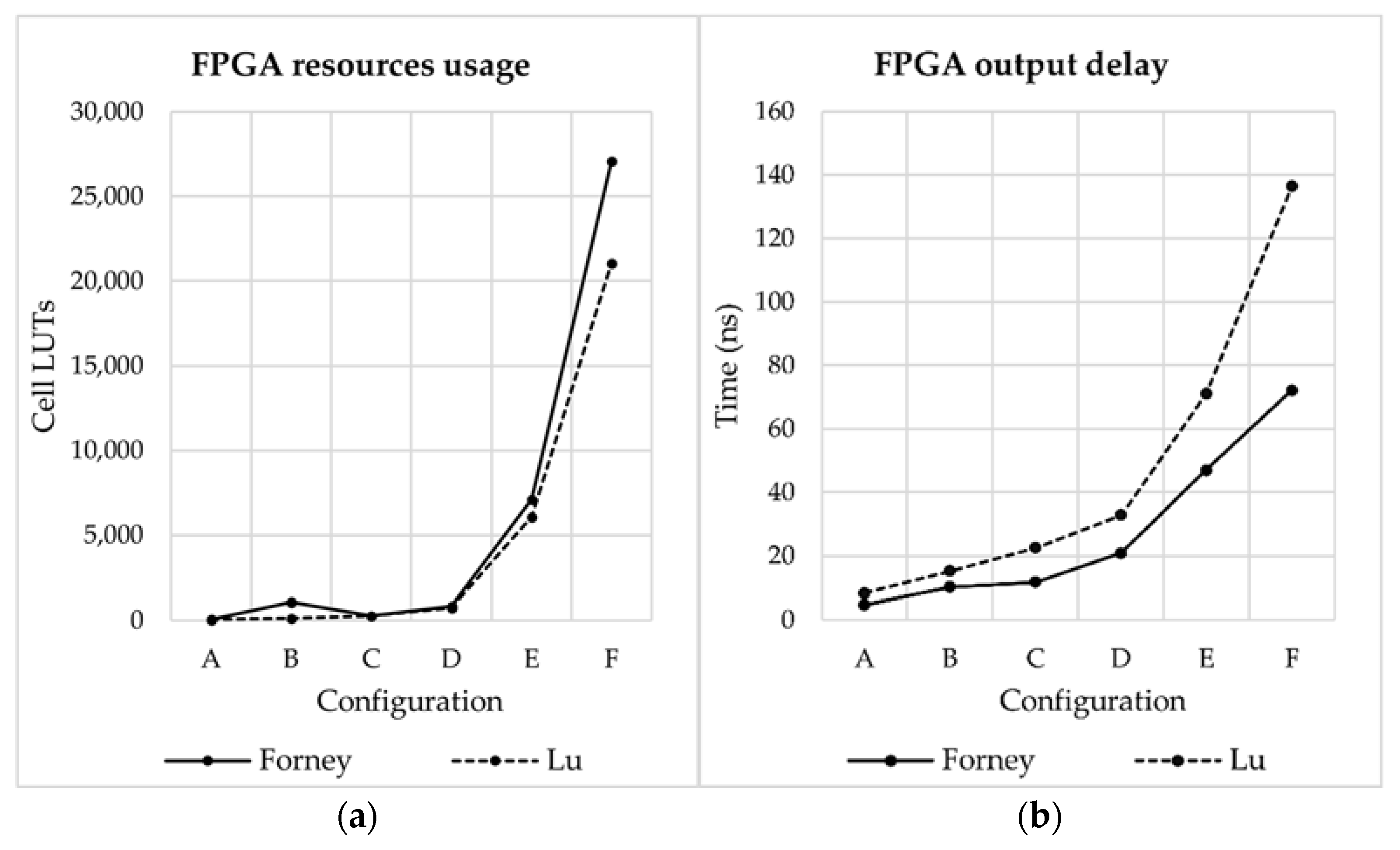

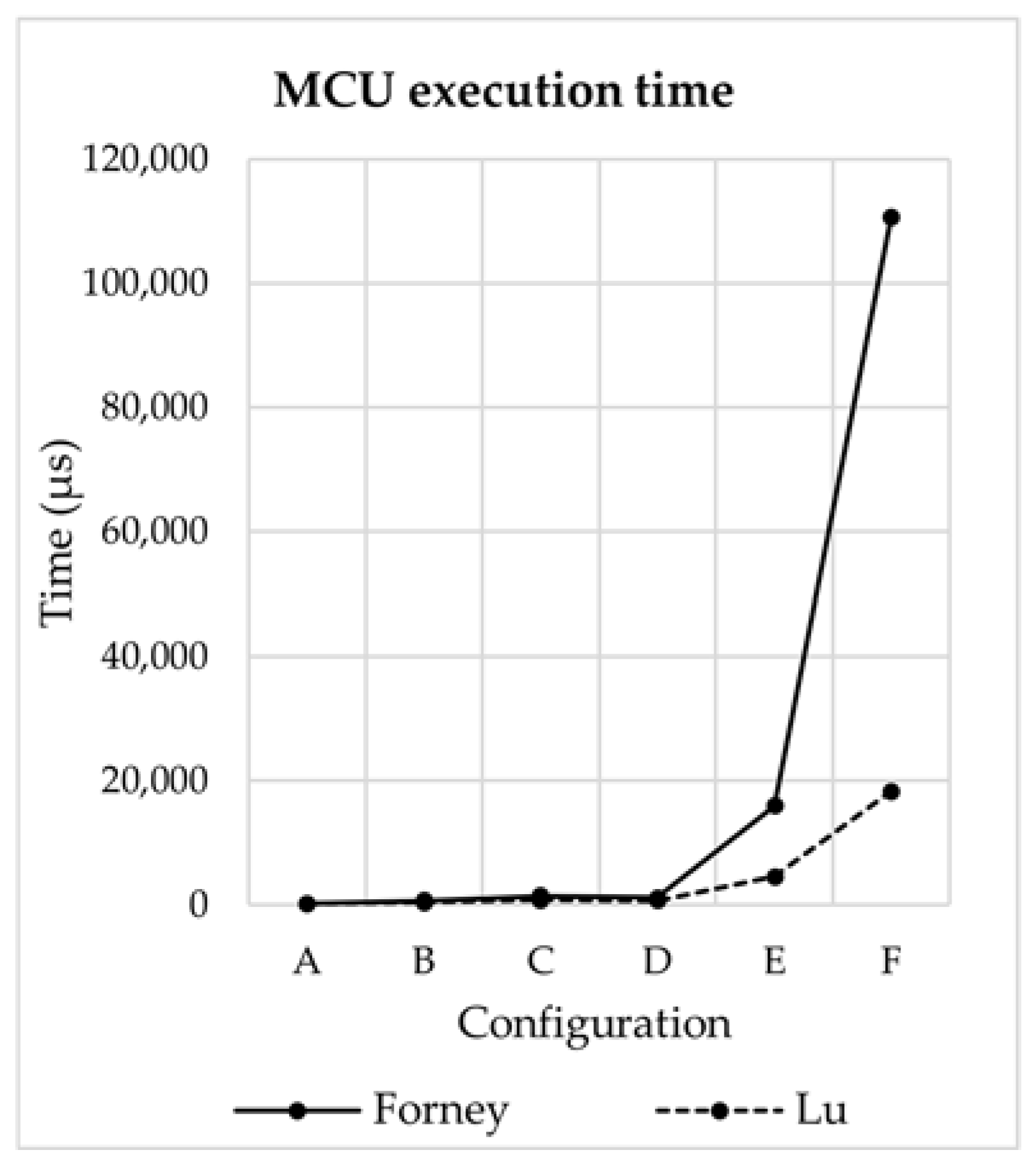
| Galois Operation | Forney’s Method | Lu’s Method |
|---|---|---|
| Addition | ||
| Multiplication | ||
| Inversion |
| Number of Errors | Forney’s Method | Lu’s Method |
|---|---|---|
| Configuration Name | m | Number of Correctable Errors (t) | |
|---|---|---|---|
| A | 4 | (15,11) | 2 |
| B | 4 | (15,9) | 3 |
| C | 4 | (15,7) | 4 |
| D | 8 | (255,249) | 3 |
| E | 8 | (255,239) | 8 |
| F | 8 | (255,223) | 16 |
| System Configuration | Forney | Lu | ||
|---|---|---|---|---|
| Cell LUTs | Time (ns) | Cell LUTs | Time (ns) | |
| A | 56 | 6.7 | 62 | 8.3 |
| B | 163 | 10.2 | 138 | 15.2 |
| C | 263 | 11.7 | 268 | 22.5 |
| D | 828 | 20.8 | 760 | 32.8 |
| E | 7126 | 47 | 6081 | 71 |
| F | 27,100 | 72.2 | 21,082 | 136.4 |
| System Configuration | Forney | Lu |
|---|---|---|
| Time (µs) | Time (µs) | |
| A | 186.1 | 169.8 |
| B | 668.1 | 389.3 |
| C | 1400 | 699.2 |
| D | 1100 | 607.3 |
| E | 15,900 | 4500 |
| F | 110,600 | 18,300 |
© 2020 by the authors. Licensee MDPI, Basel, Switzerland. This article is an open access article distributed under the terms and conditions of the Creative Commons Attribution (CC BY) license (http://creativecommons.org/licenses/by/4.0/).
Share and Cite
Bianchi, V.; Bassoli, M.; De Munari, I. Comparison of FPGA and Microcontroller Implementations of an Innovative Method for Error Magnitude Evaluation in Reed–Solomon Codes. Electronics 2020, 9, 89. https://doi.org/10.3390/electronics9010089
Bianchi V, Bassoli M, De Munari I. Comparison of FPGA and Microcontroller Implementations of an Innovative Method for Error Magnitude Evaluation in Reed–Solomon Codes. Electronics. 2020; 9(1):89. https://doi.org/10.3390/electronics9010089
Chicago/Turabian StyleBianchi, Valentina, Marco Bassoli, and Ilaria De Munari. 2020. "Comparison of FPGA and Microcontroller Implementations of an Innovative Method for Error Magnitude Evaluation in Reed–Solomon Codes" Electronics 9, no. 1: 89. https://doi.org/10.3390/electronics9010089
APA StyleBianchi, V., Bassoli, M., & De Munari, I. (2020). Comparison of FPGA and Microcontroller Implementations of an Innovative Method for Error Magnitude Evaluation in Reed–Solomon Codes. Electronics, 9(1), 89. https://doi.org/10.3390/electronics9010089






